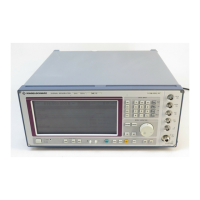SME Digital Modulation
1038.6002.02 2.131 E-13
MODE
Selection of sequence of messages and filler data.
ALWAYS The message is continuously output according to the
time interval which is set under TIME SLICE.
IEC-bus command :TRIG:DM:SOUR AUTO
SINGLE The time slices without message are continuously
output. If EXECUTE SINGLE is selected, a time slice
with the message is output once.
IEC-bus command :TRIG:DM:SOUR SING
:SOUR:POCS:TACT MESS
EXT The time slices without message are continuously
output. If EXECUTE SINGLE is selected, a time slice
with the message is output once.
IEC-bus command:TRIG:DM:SOUR EXT
:SOUR:POCS:TACT MESS
EXTTRIG The SME only starts with the generation of the
POCSAG signal after recognition of a trigger pulse
at the trigger input connector. After recognition of
this signal, exactly one message is output.
IEC-bus command::TRIG:DM:SOUR EXT;
:SOUR:POCS:TACT ONCE
EXTTRIG-ALWAYS
The units waits for a signal edge at the trigger
connector. After recognition of this edge, the unit
behaves as described under setting ALWAYS.
IEC-bus command: :TRIG:DM:SOUR EXT;
:SOUR:POCS:TACT STAR
EXECUTE SINGLE Ð
The set message is output exactly once at the next possible point
of time. This triggerable action is only displayed and active when
MODE SINGLE has been selected.
IEC-bus command *TRG
CLOCK SOURCE
Selection of the clock source. This setting is also valid for
ERMES, FLEX and REFLEX but not for the other digital
modulations.
INT The clock required for signal generation is generated
internally and can be tapped at the CLOCK connector.
EXT The signal applied to the CLOCK connector is used
as the clock signal.
Note: For all bit rates, i.e. for 1600 bps and 3200 bps, a symbol
clock rate of 3200 Hz is always used. This applies to both
the output (CLOCK SOURCE INT) and the input (CLOCK
SOURCE EXT) of the clock.
IEC-bus command :SOUR:DM:COMP:CLOC:SOUR INT

